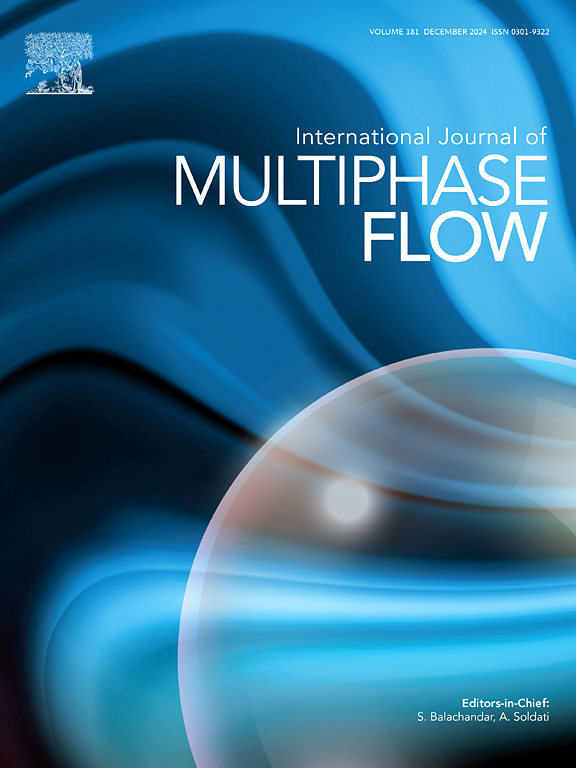粒子直接数值模拟的高保真方法
IF 3.6
2区 工程技术
Q1 MECHANICS
International Journal of Multiphase Flow
Pub Date : 2025-02-20
DOI:10.1016/j.ijmultiphaseflow.2025.105175
引用次数: 0
摘要
我们提出了一种新的计算方法,用于直接数值模拟具有完全分解颗粒(PR-DNS)的颗粒负载流。该方法基于最近发展的体积滤波浸入边界法[Dave et al . Journal of Computational Physics, 487:112136, 2023],通过对输运方程进行体积滤波得到。与其他PR-DNS方法相比,这种方法在数学和物理上都是严格的,这些方法依赖于特别的数值方案来在粒子表面施加无滑移边界条件。使用目前的PR-DNS策略,我们表明过滤器尺寸与颗粒直径的比率作为控制保真度水平的参数。在该比值很小的情况下,得到了分辨率很好的PR-DNS。相反,当过滤器尺寸与颗粒直径之比较大时,得到经典的点颗粒法。讨论了滤波方程的离散化问题,并与其他基于直接强迫浸入边界法的PR-DNS策略进行了比较。讨论了沉降分解颗粒的数值算例。本文章由计算机程序翻译,如有差异,请以英文原文为准。

A high-fidelity methodology for particle-resolved direct numerical simulations
We present a novel computational method for direct numerical simulations of particle-laden flows with fully-resolved particles (PR-DNS). The method is based on the recently developed Volume-Filtering Immersed Boundary method [Dave et al, Journal of Computational Physics, 487:112136, 2023] derived by volume-filtering the transport equations. This approach is mathematically and physically rigorous, in contrast to other PR-DNS methods which rely on ad-hoc numerical schemes to impose no-slip boundary conditions on the surface of particles. With the present PR-DNS strategy, we show that the ratio of filter size to particle diameter acts as a parameter that controls the level of fidelity. In the limit where this ratio is very small, a well-resolved PR-DNS is obtained. Conversely, when the ratio of filter size to particle diameter is large, a classic point-particle method is obtained. The discretization of the filtered equations is discussed and compared to other PR-DNS strategies based on direct-forcing immersed boundary methods. Numerical examples with sedimenting resolved particles are discussed.
求助全文
通过发布文献求助,成功后即可免费获取论文全文。
去求助
来源期刊
CiteScore
7.30
自引率
10.50%
发文量
244
审稿时长
4 months
期刊介绍:
The International Journal of Multiphase Flow publishes analytical, numerical and experimental articles of lasting interest. The scope of the journal includes all aspects of mass, momentum and energy exchange phenomena among different phases such as occur in disperse flows, gas–liquid and liquid–liquid flows, flows in porous media, boiling, granular flows and others.
The journal publishes full papers, brief communications and conference announcements.

 求助内容:
求助内容: 应助结果提醒方式:
应助结果提醒方式:


